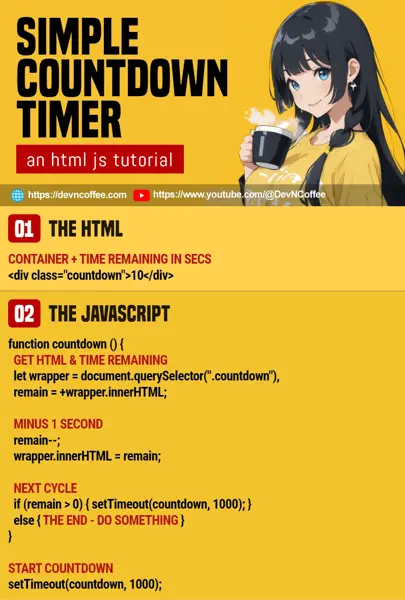Need to create a countdown timer for your web app? Well, there’s no need to bloat your web app with complicated third-party libraries. Let Master Coffee walk you through 2 simple countdown timers, all made in pure HTML CSS Javascript – Let’s go!
CODE DOWNLOAD
I have released this under the MIT license, feel free to use it in your own project – Personal or commercial. Some form of credits will be nice though. 🙂
VIDEO TUTORIAL
1) COUNTDOWN IN SECONDS
1A) DEMO
This demo is set to count down from 10 in an endless loop.
1B) THE HTML
<div class="countdown">10</div>All we need for the HTML is a <div class="countdown"> container and the number of seconds to begin with.
1C) THE JAVASCRIPT
function countdown () {
// (PART A) GET HTML & TIME REMAINING
let wrapper = document.querySelector(".countdown"),
remain = +wrapper.innerHTML - 1;
wrapper.innerHTML = remain;
// (PART B) NEXT CYCLE
if (remain > 0) { setTimeout(countdown, 1000); }
else { /* THE END - DO SOMETHING */ }
}
setTimeout(countdown, 1000);The entire countdown mechanism is contained within function countdown ().
- Get the remaining time, decrement it by 1 second, and update the HTML.
- Loop until the remaining time hits 0.
2) COUNTDOWN TO DATE
2A) DEMO
This demo is set to count down to 2 days from now.
2B) THE HTML
<div class="countdown"></div>Same as the previous example, we only need a <div class="countdown"> container, but it’s empty now.
2C) THE JAVASCRIPT
var countdown = {
// (PART A) PROPERTIES
remain : 0, // remaining time in seconds
segments : {}, // html remaining time
// (PART B) INITIALIZE
init : () => {
// (B1) NOW, TILL, REMAINING SECONDS
let now = new Date(), till = new Date();
till.setDate(till.getDate() + 2); // 2 days from now
countdown.remain = Math.floor((till - now) / 1000);
// (B2) ADD HTML TIME SEGMENTS
let add = s => {
let segment = document.createElement("div");
segment.className = "segment";
segment.innerHTML = `<div class="left"></div><div class="name">${s}</div>`;
document.querySelector(".countdown").appendChild(segment);
countdown.segments[s] = segment.querySelector(".left");
};
// 1 min = 60 sec | 1 hr = 3600 sec | 1 day = 86400 sec
if (countdown.remain >= 86400) { add("day"); }
if (countdown.remain >= 3600) { add("hr"); }
if (countdown.remain >= 60) { add("min"); }
add("sec");
// (B3) TICKER DOWN
setTimeout(countdown.ticker, 1000);
},
// (PART C) TICKER COUNTDOWN
ticker : () => {
// (C1) UPDATE REMAINING TIME
countdown.remain--;
if (countdown.remain <= 0) {
for (let v of Object.values(countdown.segments)) { v.innerHTML = 0; }
console.log("THE END - DO SOMETHING");
return;
}
// (C2) REMAINING TIME
let remain = { sec : countdown.remain };
if (remain.sec >= 60) {
remain.min = Math.floor(remain.sec / 60);
remain.sec -= remain.min * 60;
} else { remain.min = 0; }
if (remain.min >= 60) {
remain.hr = Math.floor(remain.min / 60);
remain.min -= remain.hr * 60;
} else { remain.hr = 0; }
if (remain.hr >= 24) {
remain.day = Math.floor(remain.hr / 24);
remain.hr -= remain.day * 24;
} else { remain.day = 0; }
// (C3) UPDATE HTML TIME SEGMENTS
for (let [k,v] of Object.entries(countdown.segments)) { v.innerHTML = remain[k]; }
// (C4) NEXT CYCLE
setTimeout(countdown.ticker, 1000);
}
};
// (PART D) START
window.addEventListener("load", countdown.init);This can be “scary” to some beginners, but it is easier to trace in this order:
- All of the countdown mechanics are contained within
var countdown = {}. - (B & D) On window load, we call
countdown.init().- (B1) For this example, we will countdown from now to 2 days from now –
countdown.remainis the number of seconds remaining. - (B2) Add the HTML “time remaining” segments accordingly – Days, hours, minutes, and seconds.
- (B3) Call
countdown.ticker()every 1 second to countdown.
- (B1) For this example, we will countdown from now to 2 days from now –
- (C) Countdown mechanics.
- (C1) Decrement
countdown.remain. Captain Obvious – If it hits 0, it’s the end. - (C2) Calculate the remaining time in seconds, minutes, hours, and days.
- (C3) Update the HTML time remaining.
- (C4) Loop and call
countdown.ticker()until it hits 0.
- (C1) Decrement
THE END – A COUPLE OF NOTES ON THE DATE
That’s all for this short tutorial and sharing. But before we end, here are a couple of notes on setting the date:
- There are many ways to set a date in Javascript, such as
new Date(2077, 02, 01, 12, 34, 56)andnew Date("2077-03-12T12:34:56")– You can check the Date constructor documentation for more. - By default,
new Date()is fixed to the timezone of the user’s device. - If you want an “accurate end date”, I will recommend fixing it to Date.UTC().
CHEAT SHEET

